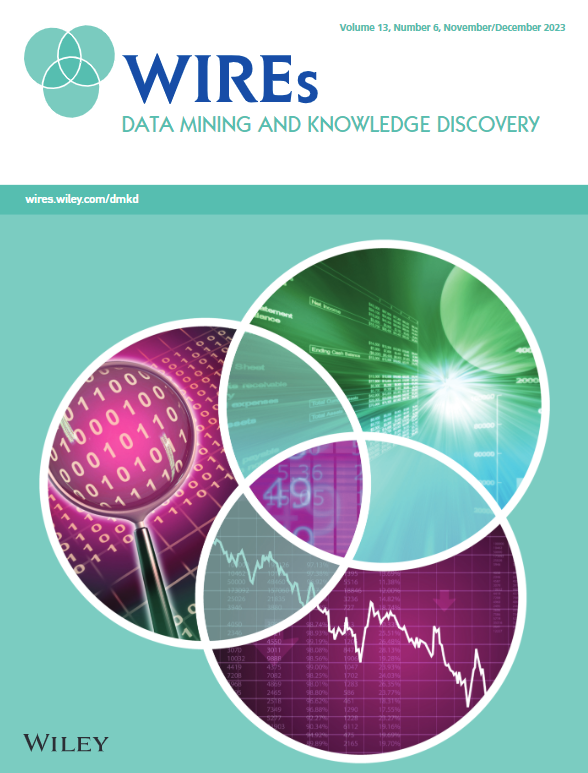Automatic segmentation to characterize anthropometric parameters and cardiovascular indicators in children
IF 11.7
2区 计算机科学
Q1 COMPUTER SCIENCE, ARTIFICIAL INTELLIGENCE
Wiley Interdisciplinary Reviews-Data Mining and Knowledge Discovery
Pub Date : 2021-05-03
DOI:10.1002/widm.1411
引用次数: 0
Abstract
A new predictive model to classify childhood obesity was implemented using machine learning techniques. The first step was to calculate the most relevant anthropomorphic and cardiovascular parameters of 187 children through principal component analysis (PCA) and cluster classification. Then Naïve‐Bayes method classified these children into six groups using anthropometric Z Score, measurements of abdominal obesity, and arterial pressure: Group I (20.32% of total): composed mainly by accentuated malnutrition and malnutrition children; Group II (36.36%): composed primarily by eutrophic children; Group III (21.4%): constituted by eutrophic plus overweight children; Group IV (14.97%): comprised mainly by overweight and obese children; Group V (5.34%): Obese and overweight children; and Group VI (1.6%): obese at risk children. From Group II to VI, the proportion of pre‐hypertensive and hypertensive children increased monotonically from 5 to 33%. This classification modes was tested on 66 children that were not originally included with a success rate of 97%. This predictive model will facilitate future longitudinal studies of obesity in children and will help plan interventions and evaluations of their results.自动分割表征儿童人体测量参数和心血管指标
使用机器学习技术实现了一种新的预测模型来对儿童肥胖进行分类。第一步是通过主成分分析(PCA)和聚类分类计算187名儿童最相关的人格化和心血管参数。然后Naïve‐Bayes方法根据人体测量Z评分、腹部肥胖和动脉压将这些儿童分为六组:第一组(占总数的20.32%):主要由重度营养不良和营养不良儿童组成;II组(36.36%):主要由富营养化儿童组成;III组(21.4%):由富营养化加超重儿童组成;第四组(14.97%):主要由超重和肥胖儿童组成;V组(5.34%):肥胖和超重儿童;第六组(1.6%):肥胖高危儿童。从II组到VI组,高血压前期和高血压患儿的比例从5%单调增加到33%。这种分类模式对66名未被纳入的儿童进行了测试,成功率为97%。这一预测模型将促进未来儿童肥胖的纵向研究,并将有助于计划干预措施和评估其结果。
本文章由计算机程序翻译,如有差异,请以英文原文为准。
求助全文
约1分钟内获得全文
求助全文
来源期刊

Wiley Interdisciplinary Reviews-Data Mining and Knowledge Discovery
COMPUTER SCIENCE, ARTIFICIAL INTELLIGENCE-COMPUTER SCIENCE, THEORY & METHODS
CiteScore
22.70
自引率
2.60%
发文量
39
审稿时长
>12 weeks
期刊介绍:
The goals of Wiley Interdisciplinary Reviews-Data Mining and Knowledge Discovery (WIREs DMKD) are multifaceted. Firstly, the journal aims to provide a comprehensive overview of the current state of data mining and knowledge discovery by featuring ongoing reviews authored by leading researchers. Secondly, it seeks to highlight the interdisciplinary nature of the field by presenting articles from diverse perspectives, covering various application areas such as technology, business, healthcare, education, government, society, and culture. Thirdly, WIREs DMKD endeavors to keep pace with the rapid advancements in data mining and knowledge discovery through regular content updates. Lastly, the journal strives to promote active engagement in the field by presenting its accomplishments and challenges in an accessible manner to a broad audience. The content of WIREs DMKD is intended to benefit upper-level undergraduate and postgraduate students, teaching and research professors in academic programs, as well as scientists and research managers in industry.
 求助内容:
求助内容: 应助结果提醒方式:
应助结果提醒方式:


